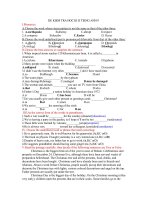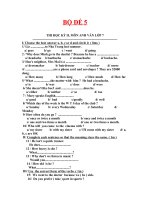Download Đề kiểm tra học kì 2 tiếng anh 11 rất hay
Bạn đang xem bản rút gọn của tài liệu. Xem và tải ngay bản đầy đủ của tài liệu tại đây (68.01 KB, 3 trang )
<span class='text_page_counter'>(1)</span><div class='page_container' data-page=1>
<b>Unit 9: THE POST OFFICE</b>
Over the past few years, Vietnam has quickly developed its telephone system.
Vietnam ranks second only to China for growth in the number of telephone
subscribers. It is among the 30 countries in the world that have more than two million
telephone subscribers.
In the early 1990s, there were only 140,000 telephones across Vietnam. At present, we
have more than six million subscribers.
In 1996, Vietnam began upgrading its fixed telephone networks and changing numbers
from six to seven digits in Hanoi and Ho Chi Ming City as well as five to six digits in other
provinces.
Five years later the mobile phone system was upgraded to meet the growth in customer demand.
Since 2000, Vietnam has reduced the price of several services, especially in the monthly fees for
fixed and mobile telephones.
In the future, more attention will be paid to the rural areas. At present, 93 percent of
communes across Vietnam have telephone services. A network of 6,014 communal post
offices have been set up across the country.
<b>Unit 10: NATURE IN DANGER</b>
In many parts of the United States, large areas of land have been made into national
parks to protect and preserve the natural beauty of the land. National parks usually contain a
variety of scenic features, such as mountains, caves, lakes, rare animals and plants. Today,
there are 52 national parks in the United States, covering approximately 3 per cent of the
total land area of the country. National parks are open to the public and have million of
visitors every year.
Many national parks, however, are in danger of being destroyed. Rare animals in
national parks are killed or hunted for fur, skin or other parts. Trees are cut down for wood.
Large areas of national parks also experience devastating fires caused by careless people.
The increasing number of visitors is harming the parks due to the pollution from their
vehicles.
If these problems are not solved immediately, and if there is not enough money for the
parks’ staff and maintenance of their resources, many national parks will be completely
destroyed.
<b>Unit 11: SOURCES OF ENERGY</b>
The natural environment includes all natural resources that are necessary for li8fe: the
air, the ocean, the sun, and the land. Because they are vital for life, these resources must be
protected from pollution and conserved. Ecologists study their importance and how to use
them carefully.
According to ecologists, resources are divided into two groups: renewable and
nonrenewable. When a resource is used, it takes some time to replace it. If the resource can
be replaced quickly, it is called renewable. For example, grass for animals is a renewable
resource. When cows eat the grass, the resource is used. If the soil is fertilized and protected,
more grass will grow. Coal, however, is nonrenewable because it takes millions of years to
make coal. All fossil fuels are nonrenewable resources.
</div>
<span class='text_page_counter'>(2)</span><div class='page_container' data-page=2>
dioxide (CO2), and other gases. If humans continue to pollute the air, it will not contain the
correct amounts of these gases.
<b>Unit 12: THE ASIAN GAMES</b>
Good evening. It’s 10.15 and it’s time for “The Asian Games Report”. It’s the 3rd<sub> day</sub>
of the Games. Well, today’s most important event was the women’s 200-metre freestyle. The
Japanese, Yuko was the first and got the gold medal. She made a new record time of 1
minute 58 seconds. The Japanese athletes won two gold medals yesterday, and three the day
before, so in the first three days they’ve won six gold medals.
Here we’re in the Gymnasium. Lily, the Chinese gymnast, has just finished her
display. She’s got an average of 9.5 points. That’s the best score today! Lily’s won the gold
medal!
...And this is Lee Bong-ju coming from Korea. This is the second time he completed in
the long jump- at the Asian Games. Last time he jumped 8.5 metres. Today he’s won a gold
medal for men’s long jump. He jumped 8.9 metres.
...Now we’re waiting for the last high jumper, Vichai coming from Thailand. The bar
is at 2.30 metres and... it seems too high for him. Vichai has just jumped! ...Ooh! He’s
crashed into the bar! He’s landing. The bar has fallen too. He’s getting up and walking away.
But he’s very disappointed.
<b>Unit 13: HOBBIES </b>
My hobby is reading. I read story books, magazines, newspapers and any kind of
material that I find interesting.
My hobby got started when I was a little boy. I had always wanted my parents to read
fairy tales and other stories to me. Soon they got fed up with having to read to me
continually. So as soon as I could, I learned to read. I started with simple ADC books. Soon I
could read fairy tales and stories. Now I read just about anything that is available.
Reading enables me to learn about so many things. I learned about how people lived in
bygone days. I learned about the wonders of the world, space travel, human achievements,
gigantic whales, tiny viruses and other fascinating things.
The wonderful thing about reading is that I do not have to learn things the very hard
way. For example, I do not have to catch a disease to know that it can kill me. I know the
danger so I can avoid it. Also I do not have to deep into the jungle to find out about tigers. I
can read all about it in a book.
Books provide the reader with so many facts and so much information. They have
certainly helped me in my daily life. I am better equipped to cope with living. Otherwise I
would go about ignorantly learning things the hard way.
So I continue to read. Reading is indeed a good hobby.
<b>Unit 14: RECREATION</b>
Three American students are talking about how they would like to spend their summer
vacation.
</div>
<span class='text_page_counter'>(3)</span><div class='page_container' data-page=3>
TERRY: I used to go to the mountains, the desert, and other places with spectacular
scenery in summer. I don’t any more, although I’m attracted to the beauty of nature. But I do
think these natural places aren’t as beautiful as they used to be. Now more and more people
are going to these places. They leave trash in the forests, and take rocks and plants with
them. They don’t care about nature. I believe not only people are important to the world
-nature is important, too.
MARY: Like most other people I’m very fond of natural spectacular scenery, but
when I travel, I spend most of my time in cities. Why I don’t want to live in nature and enjoy
it? It’s the solitude of the wilderness. It’s for animals and plants, not for me. I hate camping,
too. I can’t put up an umbrella tent in the wind. I can’t make a fire in the rain, and a backpack
is usually too heavy for me. So I’d better stay in the cities and enjoy the comfort they offer.
<b>Unit 15: SPACE CONQUEST</b>
In a speech to the Congress in 1961, the US President Kennedy challenged the nation
to put a man in the moon before the end of the decade. After the president’s speech, NASA’s
Apollo program was developed to meet the challenge.
On July 16, 1969, the Apollo 11 was launched. The astronauts on board of the
spacecraft were Neil Armstrong, Buzz Aldrin and Michael Collins.
On July 20, 1969, Neil Armstrong became the first man on the moon. He was followed
by Aldrin 40 minutes later. TO walk on the moon surface, the astronauts need to wear a
spacesuit with a portable life support system. This controlled the oxygen, temperature and
pressure inside the spacesuit.
Armstrong and Aldrin spent a total of two and a half hours on the moon’s surface.
They performed a variety of experiments and collected soil and rock samples to return to the
Earth. An American flag was left on the moon’s surface as a reminder of the achievement.
The crew of Apollo 11 returned to the Earth on July 24, 1969. They successfully
completed their historic mission. It is regarded as the greatest human efforts in the history of
man kind.
<b>Unit 16: THE WONDERS OF THE WORLD</b>
<b>THE GREAT WALL OF CHINA</b>
The Great Wall of China, which is said to be visible from the moon, winds up and
down across deserts, grasslands and mountains of 5 provinces. It is considered one of the
greatest man-made wonders in the world thanks to its magnificence and significance. In
1987, the Great Wall was listed as a World Heritage by UNESCO.
The Great Wall as we see today was mostly built during the Ming Dynasty for defence
purposes. It started in 1368 and took 200 years to complete. Some parts of the wall are much
older and go back to around 200 B.C. It stretches for about 6,000 km from east to west. The
wall is about 11 meters high and a stone roadway runs along the top of it.
</div>
<!--links-->









